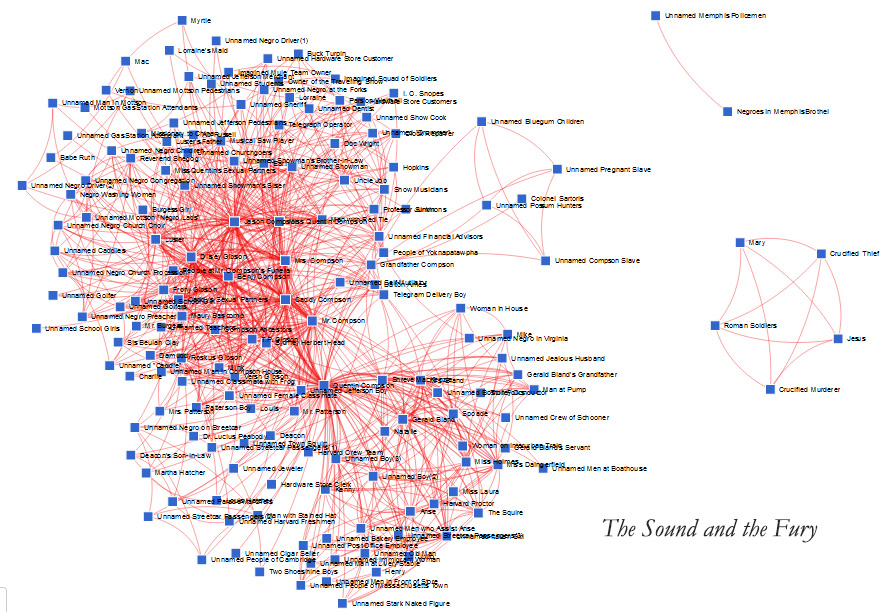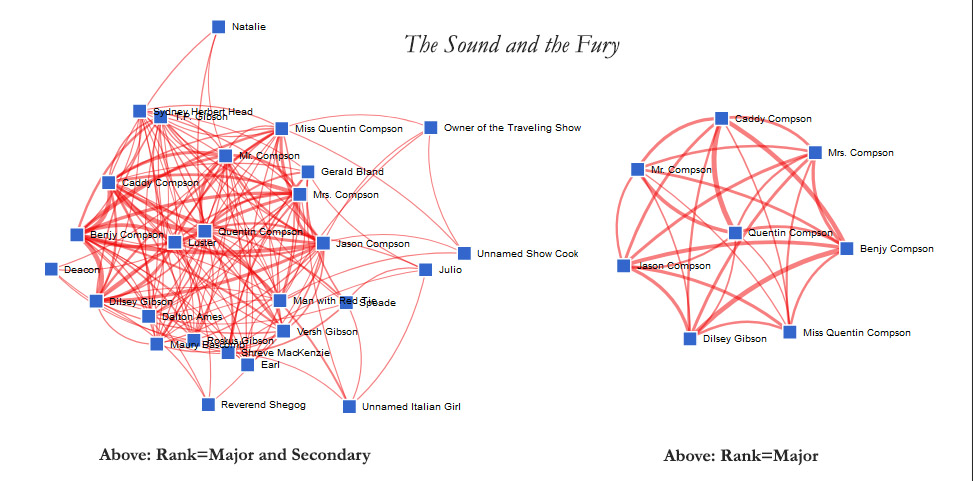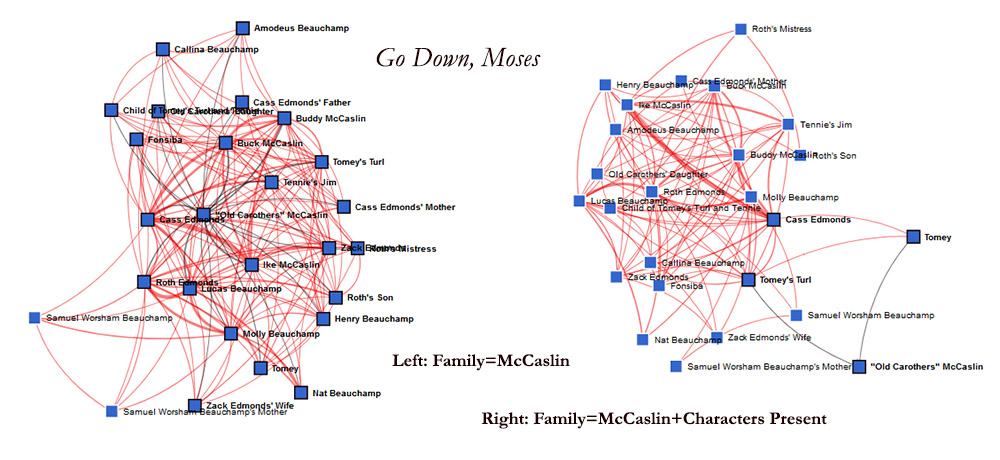Characters in Force Directed Graph
About These Graphs
|
The visualizations you can create here display the relationships among the Characters in a text as a "force directed" graph. Force directed graphs are networks of "nodes" and linking "edges" (lines) created with an algorithm that displays them somewhat like a physical system where forces of attraction and repulsion are exerted between objects. On these graphs each blue square (or "node") represents a Character; the lines between the squares ("edges") represent the frequency of any two Characters' narrative connection (how often they appear or are mentioned together in the same scene). The forces behind a force directed display can be likened to the interactions of a group of bar magnets, where each positive pole pushes away the other magnets' positive poles but is attracted to their negative poles. The charge carried by each node repels all the other nodes out to the circumference of the graph, but every instance of connection between any two of them pulls at least one member of each pair toward the middle; the more connections, the closer to the center. Also, the width of the line between pairs of Characters indicates the number of times they co-occur; the more events in which they are together in person or by being mentioned, the wider the line. A graph will exhibit a number of quantitative properties that may be relevant to the interpretation of the story. For example, one may calculate which Characters are most "central" as well as those that are most "between" the other nodes - but note, "central" is a positional concept here: closer to the center of the array, not necessarily more central to the meaning of the narrative. Many of these properties may be grasped qualitatively as well. For example, each graph may be characterized by nodes that are central, peripheral, and liminal. Faulkner's novels typically contain between 300 and 400 Characters, which can make the basic Character-Character graphs too crowded to be interpretively useful. Below, for example, are arrayed the 177 Characters we identified in The Sound and the Fury, one of Faulkner's tightest novels. Graphs can be zoomed, but even then most of the relationships remain illegible. There are good reasons to graph all of a text's Characters together, to see what patterns may emerge. Note here, for instance, the way in this iteration Mr. Compson and his two oldest children - Caddy and Quentin - seem to create a kind of center around which the rest are grouped; the way Quentin exists in between the novel's two geographical worlds - Mississippi and Massachusetts; or the distance between the novel's modern American cast and the biblical figures in the Easter sermon that Reverend Shegog preaches. There is often order to be found inside the apparent chaos of even these large scale graphs.  On the other hand, you can take control of the amount of information displayed and isolate selected aspects of a text by using the filters at the top of the page. Alone or in combination with each other, these filters will enable you to conceptualize and so analyze Faulkner's fictions in new and potentially revealing ways. Below left, for example, the graph that results from using the "Rank" field to limit the display to the Characters identified by the project's editors as "Major and Secondary." This makes it much easier to see which Characters move toward the center and which seem more marginal. Below right, just the novel's eight "Major" Characters; among the details of note here, the thickness of the line that links Caddy and Quentin.  Relations between Characters can also serve as a means to explore theme. Below left: all the members of the large McCaslin family around which the stories in Go Down, Moses revolve; note how "Old Carothers" McCaslin, the founding father of the family's racially diverse branches, is near the center. But if you filter the same McCaslin family data for instances in which Characters are "Present" together in the text, "Old Carothers" moves to the circumference and is linked to only two of his descendants. This provides a visual demonstration of the Faulknerian maxim about the past's ongoing presence: Carothers is essentially absent from the narrative, but the story it tells is nonetheless largely determined by his various legacies.  If you look closely at this last pair of graphs, you'll also see what happens when you mouse over any individual node: the lines connecting that Character to the others turn black, so you can more easily trace his or her connections amid the larger welter of edges and nodes. For more on the graphs' search options and display functionalities, please watch the x-minute video. In pursuing these explorations, it is important to understand that the force-directed algorithm is nondeterministic in how the nodes and edges are positioned. This means that each time the visualization is generated, the positioning of the nodes (top or bottom, left or right) can be different from a previous instance, even though the graph itself is the same. Quentin Compson is at the center of the first three graphs on this page, but searching The Sound and the Fury for Major Characters another time will not necessarily locate him the same way. However, the most interpretively significant features remain evident throughout the various iterations a visualization may undergo. These features include a node's size, the number of edges it has and their thickness, and its relative placement within the graph when compared to other nodes. There is one other point that needs to be made. All of the visual reconceptualizations provided in Digital Yoknapatawpha are very partial re-presentations of Faulkner's fiction. The different visualizations can call attention to different aspects of the texts, but all should be understood as provocative rather than definitive, with the potential to provide new digital pathways to help you reach your own interpretive conclusions. Citing this page: |
- Log in to post comments
